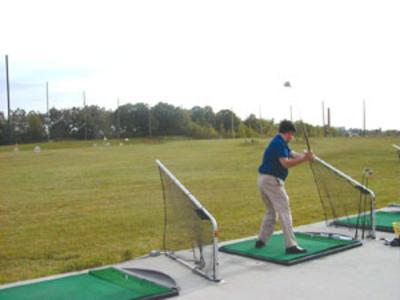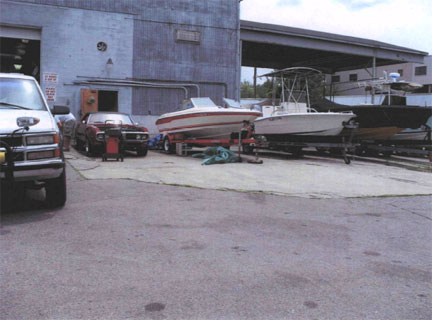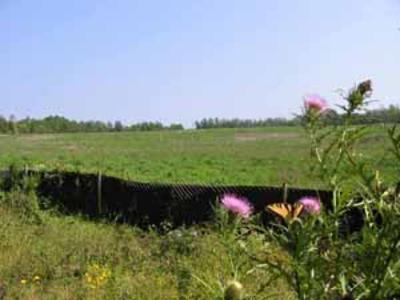Superfund Sites in Reuse in Maryland
If you are having trouble viewing the map in your browser, click the 'View larger map' link below
Bush Valley Landfill
The 16-acre Bush Valley Landfill Superfund site is in Harford County, Maryland. From 1974 to 1983, a landfill operated on the site. The landfill contaminated soil and groundwater. EPA placed the site on the National Priorities List (NPL) in 1989. Cleanup included an impermeable landfill cap to prevent further groundwater contamination, a landfill gas management system, environmental monitoring and land use restrictions. The site will remain as green space and wildlife habitat. It serves as a buffer between developed areas and the neighboring Bush Declaration Natural Resources Management Area.
Last updated September 2019
For more information:
Chemical Metals Industries, Inc. 
Last updated September 2019
For more information:
Kane & Lombard Street Drums 

 Kane & Lombard Street DrumsThe 10-acre Kane & Lombard Street Drums Superfund site is located at the corner of Kane and Lombard streets in Baltimore, Maryland. For more than 22 years, an open dump for demolition, municipal and industrial wastes operated at the site. Disposal activities resulted in the contamination of soil and groundwater. Following investigations, EPA added the site to the National Priorities List (NPL) in 1986. EPA worked closely with the community, the Maryland Department of the Environment, and a private investment group on a cleanup that was compatible with redevelopment. EPA removed waste drums, installed a subsurface barrier to prevent further contamination of groundwater, and capped contaminated soil. EPA also restricted land and groundwater use to prevent exposure to contamination. Today, site uses include a golf driving range, a parking lot, and several commercial and industrial businesses.
Kane & Lombard Street DrumsThe 10-acre Kane & Lombard Street Drums Superfund site is located at the corner of Kane and Lombard streets in Baltimore, Maryland. For more than 22 years, an open dump for demolition, municipal and industrial wastes operated at the site. Disposal activities resulted in the contamination of soil and groundwater. Following investigations, EPA added the site to the National Priorities List (NPL) in 1986. EPA worked closely with the community, the Maryland Department of the Environment, and a private investment group on a cleanup that was compatible with redevelopment. EPA removed waste drums, installed a subsurface barrier to prevent further contamination of groundwater, and capped contaminated soil. EPA also restricted land and groundwater use to prevent exposure to contamination. Today, site uses include a golf driving range, a parking lot, and several commercial and industrial businesses.
Last updated September 2019
As of December 2019, EPA had data on 5 on-site businesses. These businesses employed 99 people and generated an estimated $11,528,000 in annual sales revenue. For additional information click here.
For more information:
Mid-Atlantic Wood Preservers, Inc. 
 Mid-Atlantic Wood Preservers, Inc.The 3-acre Mid-Atlantic Wood Preservers, Inc. Superfund site is in Harmans, Maryland. A wood treatment facility operated on site from 1974 to 1993. In 1978, investigations found site soils and groundwater contaminated with chemicals from facility operations. EPA added the site to the National Priorities List (NPL) in 1986. In 1993, the site’s potentially responsible party led cleanup activities under EPA oversight. Cleanup included removing contaminated soil from a neighboring property and covering the entire 3-acre facility with an asphalt cap. In 1994, EPA entered into a prospective purchaser agreement (PPA) with Gunther’s Leasing & Transport, a neighboring property owner. The PPA enabled the company to expand its operations and use part of the site as a parking lot and for office space. Local Machine Service, Inc. leases the former treatment building on site and operates a recreational boat repair shop. The site is also used for a propane tank and fuel storage facility. Site owners also store large vehicles on site. EPA took the site off the NPL in 2000.
Mid-Atlantic Wood Preservers, Inc.The 3-acre Mid-Atlantic Wood Preservers, Inc. Superfund site is in Harmans, Maryland. A wood treatment facility operated on site from 1974 to 1993. In 1978, investigations found site soils and groundwater contaminated with chemicals from facility operations. EPA added the site to the National Priorities List (NPL) in 1986. In 1993, the site’s potentially responsible party led cleanup activities under EPA oversight. Cleanup included removing contaminated soil from a neighboring property and covering the entire 3-acre facility with an asphalt cap. In 1994, EPA entered into a prospective purchaser agreement (PPA) with Gunther’s Leasing & Transport, a neighboring property owner. The PPA enabled the company to expand its operations and use part of the site as a parking lot and for office space. Local Machine Service, Inc. leases the former treatment building on site and operates a recreational boat repair shop. The site is also used for a propane tank and fuel storage facility. Site owners also store large vehicles on site. EPA took the site off the NPL in 2000.
Last updated September 2019
As of December 2019, EPA had data on one on-site business. This business employed one person and generated an estimated $77,000 in annual sales revenue. For additional information click here.
For more information:
Middletown Road Dump
The 15-acre Middletown Road Dump Superfund site is located near Annapolis, Maryland. A dump on site accepted rubble, construction debris, and municipal and industrial waste for several decades without proper state permits. A site inspection found crushed and deteriorating drums as well as debris contaminated with hazardous substances. The dump shut down in 1981. Sampling found soil contamination threatened groundwater and nearby surface water. EPA added the site to the National Priorities List (NPL) in 1983. Cleanup activities included the removal and off-site disposal of drums, contaminated soil and debris. After cleanup, EPA took the site off the NPL in 1988. Current site uses include a residence and a landscaping business.
Last updated September 2019
As of December 2019, EPA had data on 2 on-site businesses. These businesses employed 11 people and generated an estimated $540,000 in annual sales revenue. For additional information click here.
For more information:
Ordnance Products, Inc.
The 95-acre Ordnance Products, Inc. Superfund site is in the town of North East, Maryland. From 1960 to 1972, a manufacturing plant produced ordnance products such as grenade fuses and detonators on site. Plant operators buried burned waste in open pits and discharged waste into five unlined surface locations. These practices resulted in contamination of groundwater, soil, sediment and sludge. Investigations also found site-related contamination in nearby residential drinking water wells. EPA added the site to the National Priorities List (NPL) in 1997. Cleanup included removal of hazardous materials and contaminated soil. Cleanup also included installing and maintaining treatment systems on affected residential groundwater wells to provide homes with safe drinking water. In 2012, EPA installed systems to address vapor intrusion at two houses.
Last updated September 2019
As of December 2019, EPA had data on 2 on-site businesses. These businesses generated an estimated $287,000 in annual sales revenue. For additional information click here.
For more information:
Southern Maryland Wood Treating
 Southern Maryland Wood TreatingThe Southern Maryland Wood Treating (SMWT) Superfund site is in Hollywood, Maryland. Wetlands cover most of the 94-acre area. From 1965 to 1978, wood-treating operations took place on 25 acres of the site. Wood-treating activities resulted in contamination of soil, groundwater and a stream next to the site. In the early 1980s, site owners abandoned the property, leaving processing equipment and deteriorating containers of chemicals behind. EPA added the site to the National Priorities List (NPL) in 1986. To clean up the site, EPA removed contaminated soil and sediment and heat-treated the material to remove hazardous substances. In 2000 and 2001, EPA regraded the site and planted a mix of wildflowers and grains to restore wildlife habitat on site. Groundwater monitoring ended in 2003. EPA documented that the cleanup allows for unrestricted future use in a 2004 Ready for Reuse Determination. EPA took the site off the NPL in 2005.
Southern Maryland Wood TreatingThe Southern Maryland Wood Treating (SMWT) Superfund site is in Hollywood, Maryland. Wetlands cover most of the 94-acre area. From 1965 to 1978, wood-treating operations took place on 25 acres of the site. Wood-treating activities resulted in contamination of soil, groundwater and a stream next to the site. In the early 1980s, site owners abandoned the property, leaving processing equipment and deteriorating containers of chemicals behind. EPA added the site to the National Priorities List (NPL) in 1986. To clean up the site, EPA removed contaminated soil and sediment and heat-treated the material to remove hazardous substances. In 2000 and 2001, EPA regraded the site and planted a mix of wildflowers and grains to restore wildlife habitat on site. Groundwater monitoring ended in 2003. EPA documented that the cleanup allows for unrestricted future use in a 2004 Ready for Reuse Determination. EPA took the site off the NPL in 2005.
Last updated September 2019
As of December 2019, EPA did not have economic data related to on-site businesses, or economic data were not applicable due to site use. For additional information click here.
For more information:
- Southern Maryland Wood Treating Ready for Reuse Determination (2004) (PDF) (10 pp, 743 K, About PDF)
- Superfund Site Profile Page
Woodlawn County Landfill 
The 38-acre Woodlawn County Landfill Superfund site is located in Cecil County, Maryland. A sand and gravel quarry operated on site. Cecil County then operated a municipal landfill on site from 1960 to 1978. Between 1978 and 1981, operators disposed of polyvinyl chloride industrial sludge at the site. Landfill operations contaminated soil, groundwater and sediments of a stream that crosses the site. EPA placed the site on the National Priorities List (NPL) in 1987. Under EPA oversight, the site’s potentially responsible parties (PRPs) cleaned up the site. Cleanup activities, completed in 2001, placed a vegetative soil cover over the waste. The cleanup also included monitoring of the natural breakdown of groundwater contaminants. Long-term maintenance and monitoring activities are ongoing. The PRPs installed the vegetative soil cover to support wildlife habitat and, together with an adjacent 58-acre area, the site is part of an environmental education center called “New Beginnings, the Woodlawn Wildlife Habitat Area.” Local schools, the Boy Scouts and Girl Scouts of America, and the community visit the site for nature and science projects, environmental education and recreation.
Last updated September 2019
As of December 2019, EPA did not have economic data related to on-site businesses, or economic data were not applicable due to site use. For additional information click here.
For more information:
